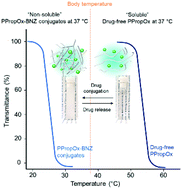Drug–polymer conjugates with dynamic cloud point temperatures based on poly(2-oxazoline) copolymers†
Abstract
A dynamic thermo-responsive drug delivery concept using poly(2-oxazoline) copolymers conjugated with a hydrophobic drug is presented. The novel strategy entails the synthesis of copolymers comprising 2-n-propyl-2-oxazoline and 2-methoxycarbonylpropyl-2-oxazoline to which the drug, benazepril is conjugated via an ester linkage. The polymer without drug is non-toxic and has a cloud point temperature in aqueous conditions around 50 °C meaning that it is soluble at body temperature. Yet, when conjugated with the drug, the cloud point temperature decreases to in between 0 and 30 °C, depending on the quantity of drug coupled to the polymer. Conversely, as the drug is cleaved via ester hydrolysis, the cloud point temperature shifts to higher temperature and the polymer becomes soluble. This shift in cloud point temperature from above to below body temperature upon modification of the polymer with the drug benazepril is hypothesized to make it suitable as an injectable soluble polymer–drug conjugate that forms an insoluble depot to slowly release the pristine drug followed by redissolution of the drug-free polymer.



 Please wait while we load your content...
Please wait while we load your content...